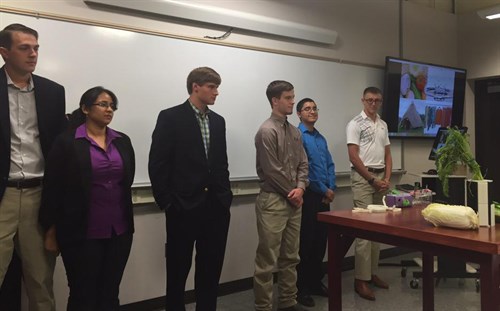The International Space Station (ISS) will soon be printing a 3-D design created by Stellarponics, a student team that placed first in the most recent Aggies Invent competition. The winning team created an innovative hydroponic system to allow fruits and vegetables to be grown more efficiently and sustainably in space.
 Aggies Invent is a unique and innovative competition that allows students the opportunity to produce and “sell” a creative solution to a proposed problem within 48 hours. This intensive, hands-on experience is held in the Engineering Innovation Center (EIC) within the Dwight Look College of Engineering at Texas A&M University.
Aggies Invent is a unique and innovative competition that allows students the opportunity to produce and “sell” a creative solution to a proposed problem within 48 hours. This intensive, hands-on experience is held in the Engineering Innovation Center (EIC) within the Dwight Look College of Engineering at Texas A&M University.
The competition is organized into four main stages: team formation, design conceptualizing, prototyping and fabrication, and presentations. The goal of this format is to help students become successful innovators, communicators and entrepreneurs in their fields.
This Aggies Invent competition focused on 3-D printing in space. Using 3-D printers in space is revolutionizing how engineers are thinking about prototypes, manufacturing and preparing for space missions. Teams were tasked with solving problems for ISS crews and long-term space missions. Needs statements for tool development, biomedical applications, crew enhancement and space station components were given to each team. Sabre Astronautics, NASA, the Department of Aerospace Engineering and others provided the needs statements.
During the event teams generated more than 150 3-D print jobs representing over 500 individual parts during the almost 30 hour prototype phase.
Industry mentors and judges were present to guide the students in their design and share real world experience. Three former astronauts, Dr. Joe Kerwin, Ken Bowersox and Dr. Greg Chamitoff, were among the mentors. The feedback from mentors pushes students toward success and expands their knowledge base.
“The opportunity to talk with heroes in our field and hear stories from space made this event special,” said Katie Schneider, a sophomore in mechanical engineering.
Other students echoed that sentiment saying that the presence of astronauts and leaders in the aerospace industry stood out as the highlight of this Aggies Invent.
The first place team, Stellarponics, consisted of Cade Capps, Sneha Chawla, Wesley Kuehn, JC Park, Joseph Valencia and Reynaldo Villarreal. Team Direct to Mars, Gilberto Arizpe, Iskander El Amri, Carlos Mejia, Milan Pandya, Mack Ragland and Fuhna Song, came in second place and SpaceSip, Bryan Carlat, Julio Gonzalez, Evan Gonzalez, Alex Jennings, Nathaniel Peirson and Victor Trujillo Jr, came in third place. The top three teams received awards of $1,000, $750 and $500, respectively.
Fifty-eight students, making up 10 multidisciplinary teams, participated in the competition. The students ranged from freshman to graduate students and came from 14 different majors.
Aggies Invent will be hosting six more events throughout the school year. The next event, Conflict, Development, and Social Entrepreneurship, will be Oct. 23-25. Registration opens on Sept. 14. More information on Aggies Invent can be found at https://aggiesinvent.tamu.edu/.